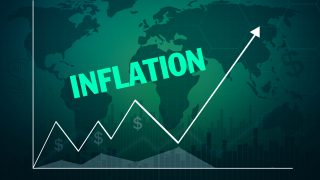Look at the chart below. Which of these two countries was the better investment?
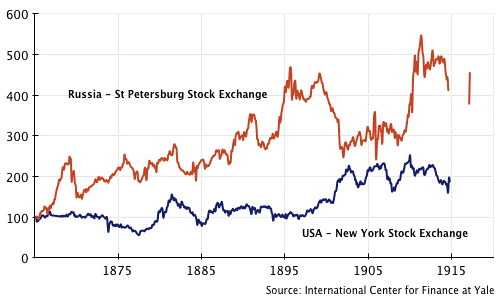
The chart shows the returns on the St. Petersburg Stock Exchange and the New York Stock Exchange from 1865 to 1917 (the data is in U.S. dollar terms and excludes dividends). During that period, Russia clearly outperformed the United States.
Russia was a big “emerging markets” development story in the late 1800s and early 1900s. It had around the sixth-largest stock market in the world and was a major recipient of foreign loans and investment, especially from France.
Then the Great War occurred between 1914-1919. Wall Street closed for six months and European markets shut down. The St. Petersburg Stock Exchange opened briefly in 1917, but when the Communists under Lenin took over, the old St. Petersburg Stock Exchange building, founded in 1865, was closed and eventually became a naval museum.
Karl Marx labeled publicly traded securities “fictitious capital,” and one of the first things the Bolsheviks did when they took over was to close the stock exchange as a case of the “vulgar” economy of the “reactionary” bourgeoisie. Russian citizens, rich and poor, lost millions.
A stock market was a no-no in the Soviet Union and other communist countries. Under communism, ownership of land, factories, companies … belonged to the state or, as the leaders liked to put it, the people. There was no share of ownership to be bought and sold, and hence, no stock market. There was not even a market for meat, vegetables, clothing, machinery, equipment and capital goods. In short, there was no need for money and exchange.
This Month Marks the 100th Anniversary of Communism
This month marks the 100th anniversary of two great forces in the world, modern day capitalism and communism. In 1917, B. C. Forbes began publishing Forbes magazine, America’s first business magazine. Bertie Forbes, his son Malcolm and his grandson Steve Forbes have been prominent in their defense of free enterprise.
Ironically, 1917 is also the time the Bolsheviks took over Russia and installed a ruthless dictatorship in the name of Marxism-Leninism. Fortunately, freedom won out, but it took more than 70 years for the Soviet Communist experiment and the Cold War to end. The St. Petersburg Stock Exchange didn’t open again until 1991.
A Prophecy Comes True
When I was a Brigham Young University (BYU) student in the 1960s, I remember listening to a BYU devotional by a Church leader who predicted that the people of the Soviet Union would be free in our lifetime. I never forgot that prophecy, despite it being seemingly impossible at the time.
It may have been in the back of my mind when I was in a debate in October 1989 with a financial guru on the subject of “The Nineties: Prosperity or Depression?” I took the side of prosperity. The debate took place in Orlando, Florida, in front of 1,000 people. In that debate, I made two predictions that seemed impossible at the time. First, we would see a balanced federal budget in the 1990s. Second, the Berlin Wall would be torn down. Both forecasts were greeted with laughter by the audience. Yet within a month, on November 9, 1989, the Berlin Wall was indeed torn down. (It wasn’t until 1999 that a small budget surprise happened.)
Growing up Under the Fear of Communism
As a young man growing up, I lived under the fear of communism and the Cold War. My father, Leroy Skousen, was, like my Uncle Cleon, an FBI agent who gave talks on the threat of communism. I read Cleon’s book, “The Naked Communist.” I remember when my uncle, along with Herb Philbrick and Fred Schwartz, among others, came to Portland, Oregon, to rally against communism. I watched the TV show, “I Lived Three Lives,” about a man who was an undercover agent and spy.
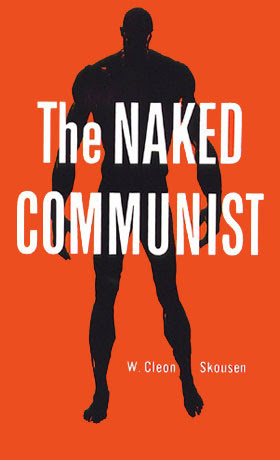
One day in the early 1960s, the family watched on nationwide TV the anti-communist rally at the Hollywood Bowl in Los Angeles, which starred Ronald Reagan, among others. At school, we practiced hiding under our desks in anticipation of a possible nuclear attack, especially during the 1962 Cuban missile crisis. Then, the Vietnam war came in the late 1960s, and all of us were given draft lottery numbers. Mine was 241, and they drafted all the boys until 240 that year. At that time, I had a strong impression that I would have the blessing of never having to fight in a war.
Ezra Taft Benson was the foremost critic of “godless” communism, and I met and corresponded with him over the years. When he was Secretary of Agriculture under President Eisenhower in the 1950s, he traveled to the Soviet Union and filed this moving report at the end of his tour:
GOING TO CHURCH IN RUSSIA (1959)
By Ezra Taft Benson
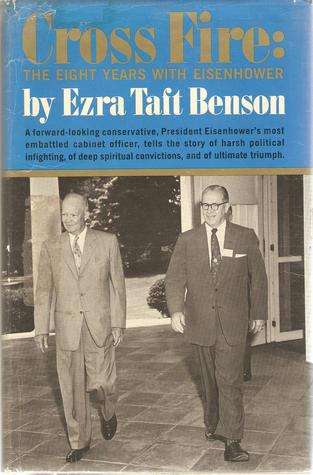
The most remarkable incident of the entire trip occurred our last evening in Moscow. On the way to the airport this last night in Moscow, I mentioned again to one of our guides my disappointment that we had had no opportunity to visit a church in Russia. He said a few words to the chauffeur, the car swung around in the middle of the avenue and we eventually pulled up before an old stucco building on a dark, narrow, cobblestone side street not far from Red Square. This was the Central Baptist Church.
It was a rainy, disagreeable October night with a distinct chill in the air. But when we entered the church, we found it filled; people were standing in the hall, in the entry, even in the street. Every Sunday, Tuesday and Thursday, we learned, similar crowds turn out.
I looked at the faces of the people. Many were middle-aged and older, but a surprising number were young. About four of every five were women, most of them with scarves about their heads. We were ushered into a place beside the pulpit.
A newsman who was present described what happened: “Every face in the old sanctuary gaped incredulously as our obviously American group was led down the aisle. They grabbed for our hands as we proceeded to our pews which were gladly vacated for our unexpected visit. Their wrinkled old faces looked at us pleadingly. They reached out to touch us almost as one would reach out for the last final caress of one’s most-beloved just before the casket is lowered. They were in misery, and yet a light shone through the misery. They gripped our hands like frightened children.”
The minister spoke a few words, and then the organ struck a chord or two and began a hymn in which the entire congregation joined as one. Hearing a thousand to 1,500 voices raised there became one of the most affecting experiences in my entire life. In our common faith as Christians, they reached out to us with a message of welcome that bridged all differences of language, of government, or history. And as I was trying to recover balance under this emotional impact, the minister asked me, through an interpreter who stood there, to address the congregation.
It took me a moment of hard struggle to master my feelings sufficiently to agree. Then I said, in part, “It was very kind of you to ask to me to greet you. I bring you greetings from the millions and millions of church people in America and around the world.” And suddenly it was the most natural thing in the world to be talking to these fellow Christians about the most sacred truths known to man.
As each sentence was translated for the congregation, I noticed for the first time that even the gallery was filled, and many persons were standing against the walls.
“I believe very firmly in prayer. I know it is possible to reach out and tap that Unseen Power which gives us strength and such an anchor in time of need.”
I don’t remember all that I said, but I recall feeling lifted up, inspired by the rapt faces of these men and women who were so steadfastly proving their faith in the God they served and loved.
In closing, I said, “I leave you my witness as a Church servant for many years that the truth will endure. Time is on the side of truth. God bless you and keep you all the days of your life, I pray in the name of Jesus Christ, Amen.”
With that I brought this broken little talk to an end, because I could say no more, and sat down. The whole congregation then broke into a favorite hymn of my childhood, “God Be with You Till We Meet Again.” We left the church as they sang and as we walked down the aisle, they waved handkerchiefs in farewell — it seemed all 1,500 were waving at us as we left.
It has been my privilege to speak before many church bodies in all parts of the world, but the impact of that experience is almost indescribable. I shall never forget that evening as long as I live.
Seldom, if ever, have I felt the oneness of mankind and the unquenchable yearning of the human heart for freedom so keenly as at that moment.
10 members of the American press who were present felt it, too. Without exception, they told me later what a moving experience it had been. On the drive to the airport, one of the interpreters, a young Russian girl who had never known any life save that under communism, said, “I felt like crying.” So did I.
— Ezra Taft Benson, Cross Fire: The Eight Years with Eisenhower (Doubleday, 1962), pp. 485-488 (excerpts).
You Blew It! Naive Intellectuals and Scholars Endorse Tyrants
“Meeting Fidel Castro was the most important eight hours of my life.”
— Steven Spielberg
Recently, a number of histories and personal accounts have been published about the greatest 20th century tragedy — Marxist-Leninist Communism — which resulted in the destruction of 100 million lives and caused untold pain. It was the deadliest experiment in human depravity.
Many naïve intellectuals and academic scholars of the West have extolled the virtues of men such as Vladimir Lenin, Joseph Stalin, Mao Zedong, Fidel Castro, Che Guevara and Hugo Chavez. Those intellectuals and scholars closed their eyes to gross human rights violations, mass murder, assassinations, show trials, gulags and starvation. Instead, those tyrants were memorialized by these romantic revolutionaries.
I highly recommend historian Paul Hollander’s new book, “From Benito Mussolini to Hugo Chavez: Intellectuals and a Century of Political Hero Worship,”
In economics, the famous MIT Keynesian economist Paul Samuelson made one of the biggest blunders in academia when he wrote as late as 1988 an edition of his popular textbook, “Economics,” “The Soviet economy is proof that, contrary to what many skeptics had earlier believed (a reference to Mises and Hayek), a socialist command economy can function and even thrive.” This statement was written a year before the collapse of the Berlin Wall.
My chapter, “Marx Madness Plunges Economics into a New Dark Age,” in my book, “The Making of Modern Economics,” is considered by one admirer as the “best critique ever written on Marx.” This chapter alone has converted many Marxists into free-market advocates.
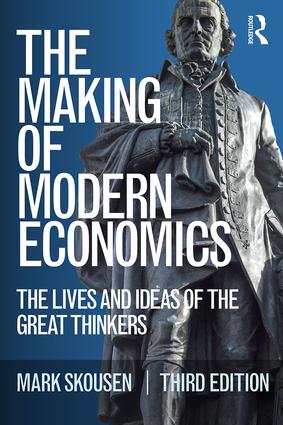
John Mackey, CEO of Whole Foods Market, has read my book three times! “I recommend it to all my friends as the best history of the great economic thinkers.” Milton Friedman has said of my book, “All histories of thought are BS — Before Skousen!”
“The Making of Modern Economics” is now in its 3rd edition and published by Routledge. The publisher charges $49.95 for the paperback, but you can get it for only $34.95 directly from Ensign Publishing. Call Harold toll free at 1-866-254-2057 to order. (Please add $15 for postage to ship outside the United States.)
UPCOMING APPEARANCE
— Orlando MoneyShow, February 8-11, 2018: I’m delighted to return to the Orlando MoneyShow, where I will be giving a new presentation on “ETFs vs. Mutual Funds, Why You Need Both! (Plus, My Five Favorites).” I’ll also be doing an encore of the “great debate” with Mike Turner on “The Economics Professor vs. the Mathematician: Buy-and-Hold vs. Market Timing.” Plus, I am on a luncheon panel to pick the next big winners with Bart DiLiddo, John Dobosz, Cody Willard and Kelley Wright. To sign up for your complimentary tickets, go to Skousen .OrlandoMoneyShow .com.



